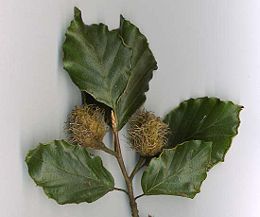Beech
2008/9 Schools Wikipedia Selection. Related subjects: Plants
- Not to be confused with Birch or Beach.
| Beech | ||||||||||||
|---|---|---|---|---|---|---|---|---|---|---|---|---|
 European Beech leaves and cupules
|
||||||||||||
| Scientific classification | ||||||||||||
|
||||||||||||
| Species | ||||||||||||
|
Fagus crenata - Japanese Beech |
Beech (Fagus) is a genus of ten species of deciduous trees in the family Fagaceae, native to temperate Europe and North America.
The leaves of beech trees are entire or sparsely toothed, from 5-15 cm long and 4-10 cm broad. The flowers are small single-sex, wind-pollinated catkins, produced in spring shortly after the new leaves appear. The bark is smooth and light gray. The fruit is a small, sharply 3-angled nut 10-15 mm long, borne in pairs in soft-spined husks 1.5-2.5 cm long, known as cupules. The nuts are edible, though bitter with a high tannin content, and are called beechmast.
Beech grows on a wide range of soil types, acid or basic, provided they are not waterlogged. The tree canopy casts dense shade, and carpets the ground with dense leaf litter, and the ground flora beneath may be sparse.
Beech was a late entrant to Great Britain after the last glaciation, and may have been restricted to basic soils in the south of England. Today, beech is widely planted for hedging and in deciduous woodlands, and mature, regenerating stands occur throughout mainland Britain below about 650 m.
The southern beeches Nothofagus previously thought closely related to beeches, are now treated as members of a separate family, Nothofagaceae. They are found in Australia, New Zealand, New Guinea, New Caledonia and South America.
The beech blight aphid (Grylloprociphilus imbricator) is a common pest of beech trees. Beeches are also used as food plants by some species of Lepidoptera (see list of Lepidoptera that feed on beeches).
Uses
The beech most commonly grown as an ornamental tree is the European Beech (Fagus sylvatica), widely cultivated in North America as well as its native Europe. Many varieties are in cultivation, notably the weeping beech F. sylvatica 'Pendula', several varieties of Copper or purple beech, the fern-leaved beech F. sylvatica 'Asplenifolia', and the tricolour beech F. sylvatica 'roseomarginata'. The strikingly columnar Dawyck beech occurs in green, gold and purple forms, named after Dawyck Garden in the Scottish Borders, one of the four garden sites of the Royal Botanic Garden Edinburgh.
The European species, Fagus sylvatica, yields a utility timber that is tough but dimensionally unstable. It is widely used for furniture framing and carcass construction, flooring and engineering purposes, in plywood and in household items like plates, but rarely as a decorative timber.
Beech wood is an excellent firewood, easily split and burning for many hours with bright but calm flames. Chips of beech wood are used in the brewing of Budweiser beer as a fining agent. Beech logs are burned to dry the malts used in some German smoked beers, to give the beers their typical flavor.
Beech wood is excellent for furnitures as well.
Also, beech pulp is used as the basis for manufacturing a textile fibre known as Modal.
The fruit of the beech, also called "Beechnuts", are found in the small burrs that drop from tree in Autumn. They are small and triangular, are edible, have a sweet taste and are highly nutritious. (~ 20% protein and also ~ 20% oil content). However, they do contain organic substances which are slightly toxic (it has been reported that eating approx. 50 nuts may make you ill) so that they should not be eaten in larger quantities. The oil pressed from them does not have this effect any more. It was in common use in Europe in times of abundant labor but scarce food sources, such as in Germany in the years immediately after World War II; people would go into the woods and collect beechnuts, then swap them for oil at small private or community-owned oil mills; the mill would keep and sell a certain percentage to cover its operating costs. As collecting beechnuts is time-consuming work, use of the oil dropped sharply when mass-produced oils became more available again.